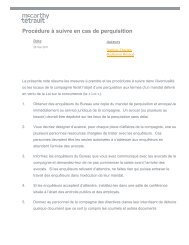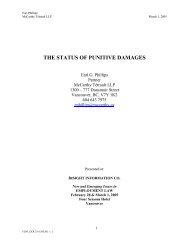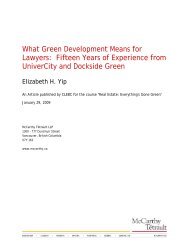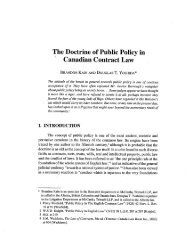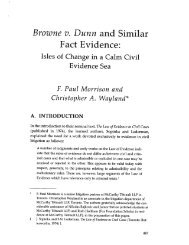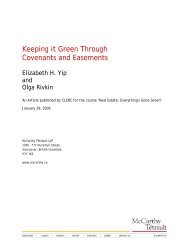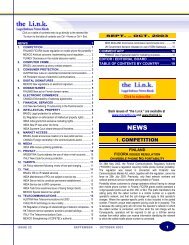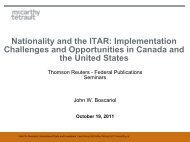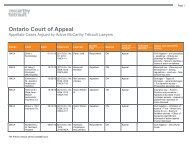Presentation Material - McCarthy Tétrault
Presentation Material - McCarthy Tétrault
Presentation Material - McCarthy Tétrault
You also want an ePaper? Increase the reach of your titles
YUMPU automatically turns print PDFs into web optimized ePapers that Google loves.
Chris Falk<br />
Stefanie Morand<br />
<strong>McCarthy</strong> Tétrault LLP<br />
taxation year will have the effect of grinding to nil the amount of the loss that can be carried<br />
back pursuant to subsection 164(6), even if the loss is substantial and the gain is only nominal.<br />
By way of example, assume the following:<br />
• Ms. Y dies owning:<br />
o<br />
a portfolio of managed publicly-traded securities, which securities are assumed<br />
(for illustrative purposes) not to have had any accrued gain or loss on death; and<br />
o all of the shares of a private corporation, YCo, with PUC of $100,000.<br />
• The shares of YCo were held by Ms. Y as capital property for purposes of the Act and<br />
had an ACB to Ms. Y of $100,000 and an FMV immediately prior to Ms. Y’s death of<br />
$1,000,000. Accordingly, the deemed disposition of the YCo shares gives rise to a<br />
$900,000 capital gain in Ms. Y’s terminal year.<br />
• In the estate’s first taxation year, YCo redeems 50% of the shares held by the estate for<br />
$500,000. 61 As a result of the redemption, the estate sustains a $450,000 capital loss.<br />
The estate is also deemed to have received a $450,000 dividend (i.e., the amount by<br />
which the redemption proceeds exceed the PUC of the shares that were redeemed).<br />
The estate should be entitled to elect pursuant to subsection 164(6) to apply the loss sustained<br />
on the redemption against the gain realized on the disposition on death.<br />
However, assume further that, in the ordinary course, a nominal capital gain (e.g., $1) is<br />
realized on the publicly-traded securities such that the net capital loss of the estate in its first<br />
taxation year is $449,999 rather than $450,000.<br />
Prior to the application of subsection 40(3.6), the maximum amount that the estate would be<br />
able to elect to carry back pursuant to subsection 164(6) is $449,999 (i.e., the estate’s net<br />
capital loss for its first taxation year assuming that subsection 40(3.6) does not apply).<br />
Subsection 40(3.61) provides that subsection 40(3.6) will apply in respect of the loss on the<br />
redemption to the extent that the amount of the loss (i.e., $450,000) exceeds the portion of the<br />
loss to which the subsection 164(6) election applies (i.e., $449,999). As a consequence, $1 of<br />
the loss on the redemption is denied pursuant to subsection 40(3.6).<br />
If subsections 40(3.6), 40(3.61) and 164(6) are interpreted iteratively (i.e., in a manner giving<br />
rise to the circularity concern), one must recalculate the amount of the subsection 164(6)<br />
election to account for the amount of the loss denied pursuant to subsection 40(3.6). This<br />
recalculation, in turn, will affect the subsection 40(3.61) calculation and so on, with the end<br />
result that no amount may be carried back pursuant to subsection 164(6).<br />
As discussed in more detail below under the heading “Statutory Interpretation”, in the authors’<br />
view, this interpretation should be rejected since it leads to an absurd result that is clearly<br />
contrary to the context and purpose of subsections 40(3.61) and 164(6).<br />
61<br />
As YCo’s sole shareholder, the estate is affiliated with YCo pursuant to section 251.1 both prior to and following<br />
the redemption.<br />
560600/422632<br />
MT DOCS 11864055v1G<br />
21



